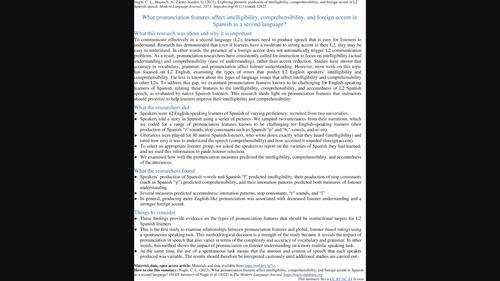当前位置:
X-MOL 学术
›
Mod. Lang. J.
›
论文详情
Our official English website, www.x-mol.net, welcomes your feedback! (Note: you will need to create a separate account there.)
Exploring phonetic predictors of intelligibility, comprehensibility, and foreign accent in L2 Spanish speech
The Modern Language Journal ( IF 7.500 ) Pub Date : 2023-04-26 , DOI: 10.1111/modl.12827 Charlie L. Nagle 1 , Amanda Huensch 2 , Germán Zárate–Sández 3
The Modern Language Journal ( IF 7.500 ) Pub Date : 2023-04-26 , DOI: 10.1111/modl.12827 Charlie L. Nagle 1 , Amanda Huensch 2 , Germán Zárate–Sández 3
Affiliation

|
Although current approaches to second language (L2) pronunciation underscore that instruction should concentrate on pronunciation features that help learners be more intelligible (and not necessarily more native like), there is little empirical evidence as to what those features are, especially in languages other than English. To address this gap, this exploratory study examined phonetic predictors of listener-based dimensions—namely, intelligibility, comprehensibility, and foreign accent—in L2 Spanish speech. Samples were taken from 42 Spanish learners of varying proficiency while performing a picture description task, rated for global measures by 80 native Spanish listeners, coded for phonemic errors, and analyzed phonetically for pronunciation features that previous research has reported as challenging for English-speaking learners. Mixed-effects models were fit to the data to examine relationships between the phonetic features and the listener-based dimensions. Results revealed that rising intonation and diphthongization of word-final /o/ predicted intelligibility, rising intonation predicted comprehensibility, and a variety of features were associated with foreign accent. Overall, results confirmed that non-target-like production of L2 pronunciation, including areas known to be challenging for Spanish learners, does not necessarily lead to intelligibility and comprehensibility issues. Based on these findings, we make recommendations regarding what features should be prioritized in L2 pronunciation instruction.
中文翻译:

探索二语西班牙语演讲中可理解性、可理解性和外国口音的语音预测因子
尽管目前的第二语言 (L2) 发音方法强调教学应该集中在帮助学习者更容易理解的发音特征上(不一定更像母语),但关于这些特征是什么的实证证据很少,尤其是在非英语语言中英语。为了解决这一差距,这项探索性研究检查了 L2 西班牙语语音中基于听众维度的语音预测因子,即可理解性、可理解性和外国口音。样本取自 42 名不同熟练程度的西班牙语学习者,同时执行图片描述任务,由 80 名西班牙语母语听众对全球措施进行评分,针对音位错误进行编码,并对发音特征进行语音分析,之前的研究报告称这些发音特征对英语学习者具有挑战性. 混合效应模型适用于数据,以检查语音特征与基于听众的维度之间的关系。结果显示,词尾 /o/ 的升调和双元音化预测可理解性,升调预测可理解性,并且多种特征与外国口音相关。总体而言,结果证实,二语发音的非目标类发音,包括已知对西班牙语学习者具有挑战性的领域,不一定会导致可理解性和可理解性问题。基于这些发现,我们就二语发音教学中应优先考虑哪些特征提出了建议。结果显示,词尾 /o/ 的升调和双元音化预测可理解性,升调预测可理解性,并且多种特征与外国口音相关。总体而言,结果证实,二语发音的非目标类发音,包括已知对西班牙语学习者具有挑战性的领域,不一定会导致可理解性和可理解性问题。基于这些发现,我们就二语发音教学中应优先考虑哪些特征提出了建议。结果显示,词尾 /o/ 的升调和双元音化预测可理解性,升调预测可理解性,并且多种特征与外国口音相关。总体而言,结果证实,二语发音的非目标类发音,包括已知对西班牙语学习者具有挑战性的领域,不一定会导致可理解性和可理解性问题。基于这些发现,我们就二语发音教学中应优先考虑哪些特征提出了建议。包括已知对西班牙语学习者具有挑战性的领域,不一定会导致可理解性和可理解性问题。基于这些发现,我们就二语发音教学中应优先考虑哪些特征提出了建议。包括已知对西班牙语学习者具有挑战性的领域,不一定会导致可理解性和可理解性问题。基于这些发现,我们就二语发音教学中应优先考虑哪些特征提出了建议。
更新日期:2023-04-26
中文翻译:

探索二语西班牙语演讲中可理解性、可理解性和外国口音的语音预测因子
尽管目前的第二语言 (L2) 发音方法强调教学应该集中在帮助学习者更容易理解的发音特征上(不一定更像母语),但关于这些特征是什么的实证证据很少,尤其是在非英语语言中英语。为了解决这一差距,这项探索性研究检查了 L2 西班牙语语音中基于听众维度的语音预测因子,即可理解性、可理解性和外国口音。样本取自 42 名不同熟练程度的西班牙语学习者,同时执行图片描述任务,由 80 名西班牙语母语听众对全球措施进行评分,针对音位错误进行编码,并对发音特征进行语音分析,之前的研究报告称这些发音特征对英语学习者具有挑战性. 混合效应模型适用于数据,以检查语音特征与基于听众的维度之间的关系。结果显示,词尾 /o/ 的升调和双元音化预测可理解性,升调预测可理解性,并且多种特征与外国口音相关。总体而言,结果证实,二语发音的非目标类发音,包括已知对西班牙语学习者具有挑战性的领域,不一定会导致可理解性和可理解性问题。基于这些发现,我们就二语发音教学中应优先考虑哪些特征提出了建议。结果显示,词尾 /o/ 的升调和双元音化预测可理解性,升调预测可理解性,并且多种特征与外国口音相关。总体而言,结果证实,二语发音的非目标类发音,包括已知对西班牙语学习者具有挑战性的领域,不一定会导致可理解性和可理解性问题。基于这些发现,我们就二语发音教学中应优先考虑哪些特征提出了建议。结果显示,词尾 /o/ 的升调和双元音化预测可理解性,升调预测可理解性,并且多种特征与外国口音相关。总体而言,结果证实,二语发音的非目标类发音,包括已知对西班牙语学习者具有挑战性的领域,不一定会导致可理解性和可理解性问题。基于这些发现,我们就二语发音教学中应优先考虑哪些特征提出了建议。包括已知对西班牙语学习者具有挑战性的领域,不一定会导致可理解性和可理解性问题。基于这些发现,我们就二语发音教学中应优先考虑哪些特征提出了建议。包括已知对西班牙语学习者具有挑战性的领域,不一定会导致可理解性和可理解性问题。基于这些发现,我们就二语发音教学中应优先考虑哪些特征提出了建议。


























 京公网安备 11010802027423号
京公网安备 11010802027423号